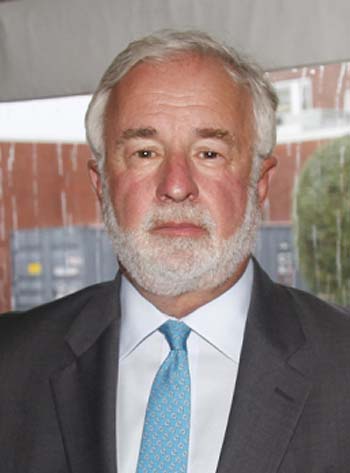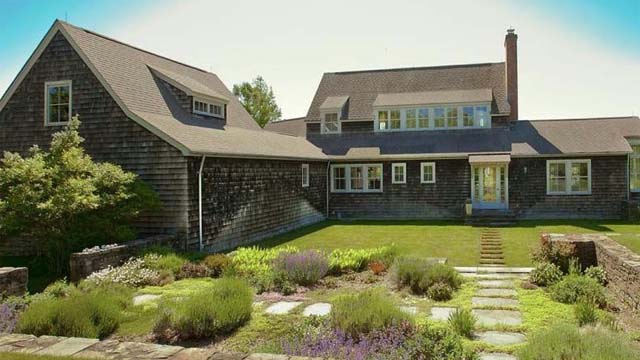I recently met with Congressman Tim Bishop in his Southampton office to discuss a report issued by the National Association of Realtors regarding housing demographics for all congressional districts in the country. Those for the 1st congressional district included the following: total number of units 307,430, homeownership rate 79.2%, vacancy rate 19%, median household income $83,144, and median home value $378,100.
Congressman Bishop, given the diversity of your district, which includes the Hamptons and North Fork of Eastern Long Island, Riverhead and parts of Brookhaven, please share with us your insights regarding the issue of housing within the context of affordability, preservation, economic development, and the needs of seniors and families.
 |
|
Congressman Tim Bishop this summer at Southampton Hospital. (Photo: PatrickMcMullan.com) |
Bishop: Let me start by saying that at least east of Riverhead, one of the largest industries is everything associated with the second home industry on Eastern Long Island. The week that Lehman Brothers collapsed in September 2008, sixteen homes that were under construction on Eastern Long Island stopped, at least temporarily. At the time, I wasn’t that worried about the sixteen homeowners. I felt that they would be O.K. I was really worried about the several hundred carpenters, plumbers, electricians, sheetrock workers, irrigation specialists, tennis court installers, swimming pool installers, landscapers, that’s a huge piece of the Eastern Long Island economy.
How we might address issues of preservation and development which, in effect, are often in competition with each other?
Bishop: What we need is balance. We need construction, which is essential to our economy. We need to preserve open space, because it makes construction attractive, we need stable beaches, clean water. I think Eastern Long Island has done a good job of balancing these needs. I think we have done a good job of preserving open space, partly through zoning, partly through the Community Preservation fund, partly through enlightened land use decisions Town Boards have made. I think we have done a good job in maintaining an appropriate balance.
Address the large disparity between the cost of housing on the South Fork as compared to the North Fork, and even more so throughout Riverhead and Brookhaven.
Bishop: The South Fork is unique, unless you include the “Gold Coast” of Florida, the “Gold Coast” of Long Island, Santa Monica, parts of the “Cape,” but there aren’t too many other places like the East End of Long Island where real estate values are as high as they are an where the economy is as dependent on high-end real estate as is the case here. As you move further west, the composition of the housing stock changes, zoning changes, land use decisions change, the availability or lack thereof changes. Take a community like Mastic Beach, which is decidedly middle class, working class, right on Moriches Bay. You have homes every quarter acre, it is very densely populated, and will be very difficult to preserve as we deal with sea level rise and severe weather patterns because it is so low and difficult to protect.
Contrast the North Fork and the Hamptons/South Fork.
Bishop: This is anecdotal, but I think the North Fork is where the South Fork was sixty years ago. It is decidedly more rural than the South Fork. Property values are nowhere near as elevated or inflated as those on the South Fork. There is lots of open space, more so than the South Fork. I would like to see the North Fork stay as it is. A big piece of why the North Fork is at is now was the advent of the vineyards. How many thousands of acres of cultivation as vineyards might have been subdivided and become plots for ‘McMansions’?
What about the controversy that some of the vineyards have generated, such as Vineyard 48 in Cutchogue? They have gone beyond merely operating as vineyards, and gotten into sponsoring “events” to which many of the residents of the North Fork object.
Bishop: Yes. I am aware of that, and I would say, again, this is an area where balance is required. In terms of economic development, agro-tourism is a really good thing, and vastly better for maintaining the character of our area than other kinds of economic development. I would imagine that the parking issue on the North Road is a safety issue that the Town is rightly concerned with; part of it is an infringement issue which again, the Town is rightly concerned with, but, I would also bet that, irrespective of this particular controversy, the Town Board would rather see a vineyard than a manufacturing plant. I think that from the point of view of what kind of economic development is most compatible with our environment, agro-tourism is right there. If you have some bad actors, then it is appropriate for the Town to deal with that. I drive the North Road in October, and I think that Harbes Farm is overflowing with traffic is a good thing, not a bad thing.
Congressman, a major concern is the fact that young people are moving away from the East End mainly due to the lack of affordable housing and job opportunities for college educated and skilled young men and women.
Bishop: Again, I would say it’s a matter of finding the right balance. I have a daughter who is a teacher in Hampton Bays. She lives with us. As far as I’m concerned, she could live with us for the rest of her life, if that was what she wants. But she lives with us, not out of choice, but necessity. She grew up in Southampton, would like to live in Southampton, but it’s awfully hard finding a place that you can rent on a year-round basis that is affordable, never mind buy. I’m a member of a twelfth generation family that his lived in Southampton. I’m willing to bet that I am also a member of the last generation of my family to live in the Village of Southampton. My older daughter was able to buy a foreclosure in North Sea that if it were in Southampton Village would have been at least double the price. The high cost of housing on the South Fork has been a problem for years, and the nature of the economy is such that the demand for skilled labor is not as high as it is further west. But you also have plumbers making $100,000 a year and teachers making $60,000, but that’s the nature of our economy.
 |
|
Beautiful 1.1 waterfront acre with quite a view that can accommodate a house, waterfront pool and cabana. Listed for $1,999,000 by Ann Ciardullo of Sotheby’s. (Courtesy Photo) |
Given what you just said, what do you think we need as far as housing is concerned?
Bishop: I think we need a more available and affordable rental stock. For example, if Southampton Hospital wherever to move to the Southampton College Campus, I think, if the building on Meeting House Lane were to become available, turning that into rental housing for young people is something that ought to be actively pursued. If you look at the institutions, Southampton Fire Department is having a hard time bringing young people in to replace the generation that is getting ready to retire. Every Fire Department on the East End is having that problem, because, what keeps a young person here who has gone off to college and comes back with a degree is the ability to afford to stay here.
One benefit associated with people moving to more costly housing is it makes the less costly home they are vacating available to someone else. That doesn’t work when we are talking about housing in the Hamptons, does it?
Bishop: No. In fact, just the opposite happens. I live two hundred yards from where I grew up. My neighborhood use to be a year round neighborhood. No seasonal residents at all. Lots of kids, blue-collar families. As the homes passed on, that’s no longer the case. I bought my house in 1978. If I had to buy it today, I could no longer afford it. Unless I leave it to my kids, whoever buys it, will mostly likely knock it down and build new. On my street in the last five years, five houses have been knocked down, and my street has forty houses. Knock downs of old houses replaced with new houses is a very prominent development, particularly within the villages.
How many of the residents of East Hampton and Southampton are actually your constituents? In other words, are registered to vote in your district?
Bishop: A minority of those are registered to vote in my district. 711,000 people live in my district, of which there are 400,000 registered voters. The vast majority of those are year round residents in places like Southold, Riverhead, and parts of Brookhaven.
Then is it correct that the vast majority of your constituents are those who live and work in your district year round?
Bishop: My principal area of concern is the traditional year round resident of the area. We have a thriving business district in Southampton as well as East Hampton and Brookhaven which would not even approach what it is if not for the seasonal population because of the “trickle down” effect that it has on our economy. If you look at what we pay in property taxes as compared to areas such as Patchogue, we have to be paying considerably less because of the seasonal homeowners who also do not use the services year round.
Given these legitimate and often competing needs, who is best positioned to address them?
Bishop: I think the primacy rests with the level of government that is closest to the day to day issues that affect the area, but I think it is a partnership. For example, if we’re talking about workforce housing, that has to be a partnership of state and local policy, the development of affordable housing policies, land use policies, open space preservation. In our areas, I think the Towns and the County have done an excellent job on open space preservation. I have spent an enormous amount of time with the Army Corps of Engineers in their efforts to stabilize and secure beaches. My home is worth multiples of what it was worth when I bought it in 1978. It wouldn’t be if there were not a gorgeous beach a mile away from my home, if that beach had been severely eroded. Preventing erosion is an obligation that the federal government has.
What are your thoughts on the future of Plum Island?
Bishop: What the Town of Southold has done in the terms of zoning is brilliant. I think it is the best tool in our tool box to keep Plum Island undeveloped and in its current state, and I hope it will convince my colleagues in the congress that continued pursuit of the sale of the island is unwise. I have offered legislation that has bi-partisan support that would decouple the future of Plum Island from the decision on the future of Plum Island from that of facility in Kansas. I hope that now that we have in place law that dramatically drives down the real estate value of Plum Island, that will help generate a groundswell for continued ownership by the federal government rather than sell it. Because if you did sell it, the clean-up costs alone would eat up the proceeds of the sale.
 |
|
On 1.6 +/- acres surrounded by English style gardens with terraced, stacked stone walls and complemented by a foot bridge leading to two ponds, this lovely two-story shingled modern style barn features first floor master with sun porch. Listed for $3,950,000 by Marilyn Clark of Sotheby’s. (Courtesy Photo) |






